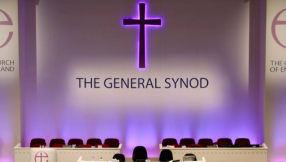Keeping places of worship in good shape
DE: The ones who even apply for grants are the ones who have managed to get that far but we are aware that there are many who don’t even get that far because they are so completely overwhelmed by the thought of major projects.
But we also had a lot of anecdotal evidence of worry and decided to listen to congregations to hear what they are actually saying. We set up six consultations around the country and what we picked up from those who participated is that people are very confused about who they have to go to for help and permission and where they might get funding from.
The guidance booklet is based on what came out of those conversations, listening to people in church halls talking about their buildings.
CT: Something like 30% said they would have had to close their buildings if they hadn’t received grants. Did that figure surprise you?
DE: They didn’t mean close permanently but rather that if they hadn’t received the grant or the listed places of worship scheme grant they wouldn’t have been able to get on and do repairs in a timely way and, therefore, part of or all of their buildings would have had to be closed because they couldn’t be confident that nothing was going to fall on people’s heads.
These people are speaking with the benefit of hindsight but it does flag up the level of concern. Nearly two thirds said they were always concerned by the prospect of major repairs and given that our researchers found that only 10% of buildings are in a situation where they need urgent major repairs, that’s an interesting state of anxiety.
CT: Do you think they are worrying because they don’t understand the structural problems of their buildings or is it a case of over-worrying?
DE: We’re going to explore it further but it may be that people don’t realise that doing small things really well, like clearing the gutters after the autumn leaves have fallen or removing dead pigeons and the odd football, can make a big difference. It’s not exciting or spectacular but it can actually make a massive contribution to keeping your building in good health. A lot of people worry that they need to replace the whole of the aisle roof whereas actually if they were able to arrange to get the gutters cleared and fix the odd tile or the odd split in a piece of lead, that would be much, much less expensive, much less exciting, but much less worrying!
CT: Did you get the impression from the people who took part in the consultation that they felt there should be more funding available to them? Were they happy with the level of funding available?
DE: I think people will always want more funding but what we did find was that people were hugely grateful when funding was made available and in particular a separate piece of research we did into the listed places of worship scheme - which gives a grant equivalent to VAT as a retrospective reimbursement. People were hugely grateful for that partly because it’s a very quick turnaround scheme. It’s very simple. The application scheme is readily understood, the people who operate the scheme are enormously approachable on the telephone, and they deal with it quickly.
The popularity of that scheme is enormous and that’s why there’s such a groundswell of opinion and letters to MPs, because it is due to end next March. It’s not just that £12 million is being lost to repairs but it is a grant scheme that is readily available to all. It was appreciated precisely because it did enable people to do small things, like hiring a local contractor to come up and clean their gutters or fix a few tiles rather than looking from the ground and thinking ‘I’m too old to get up that ladder, I can’t do it’ and then getting overwhelmed.
CT: You asked the Government to continue its share of the funding. Has their response to that been positive?
DE: I think the Government recognises that places of worship are the single largest component of our historic environment and that they are maintained exclusively by volunteers who aren’t there as historic buildings people but who are there as faith groups with a completely different agenda. Caring for the buildings on behalf of the whole community is something done by a very small number of people when it is not actually their primary reason for gathering and the government is aware of that.
One of the things we hope to do is make the general population understand that there is no pot of gold somewhere that’s financing these buildings. They are paid for by and large by the people who worship in them and that is a huge responsibility.
CT: Some people criticise churches for charging an entry fee to help cover their costs. How likely is it that more funding will be made available to churches?
DE: In the present climate there is no way that the resources available are going to be increased from taxpayers. But there is always hope that other private funders will step forward or that things will change so that there will be more money available from the Heritage Lottery Fund and other bodies.
It is important to remember that in 2009 over 80% of the adult population went into a place of worship, not for worship necessarily but for a conference or the awarding of degrees or an exhibition or concert. There are dozens of different reasons why people might go into places of worship. These buildings are not just the private property of the worshipping congregation but are very much community spaces and that is important to remember.
CT: The consultation was multi-faith. Did you encounter similar problems between the different faiths?
DE: They were all amazingly surprised by how interfaith and ecumenical their concerns were and lots of people found that they shared misunderstandings and anxieties but they were also able to share a lot of good ideas about how to work together and support one another and how to work with local authorities more effectively.
We did find that most denominations and particularly those that are not supported by a national network or advisory body were very isolated and didn’t know that they could seek informal advice from their local authority and they didn’t understand that if the local authority granted permission for work to be done then that didn’t automatically mean that there wouldn’t be funding.
We had an instance of a person from a church who stood up and said our architect had told them not to go to the local authority because they just say no and the person sitting next to him said ‘Well, that’s funny because I’m the person from the local authority that you would be talking to and I’m desperate to do something creative and have had no idea how to get in touch with anyone from the church’. The two arranged a time when they could meet up on site and they were able to talk about things more positively.
CT: So it seems like there is a communication problem?
DE: There is a huge communication problem. And one of the things we sought to do with the booklet was to make it easier for places of worship to find out what is already there because in some ways there is so much guidance where do you start, and on the other hand there are people who feel overwhelmed and think they are all on their own.
We really felt this was a good time to address people’s concerns but also give them a helping hand to grapple with the issues they are concerned about. The guidance will go out to all those who look after listed places of worship. We have also produced a DVD featuring the leaders of a synagogue, a rural Anglican church, a Methodist church in Cornwall and a New Testament church in central London sharing their experiences and hope it will help people to see that their problems are not unique to them and that there are creative ways that can make a difference.
You don’t have to turn your building into a cinema or a cafe or a computer centre to make it survive. There are lots of small things you can do and lots of people out there are doing the small things that make a big difference.













